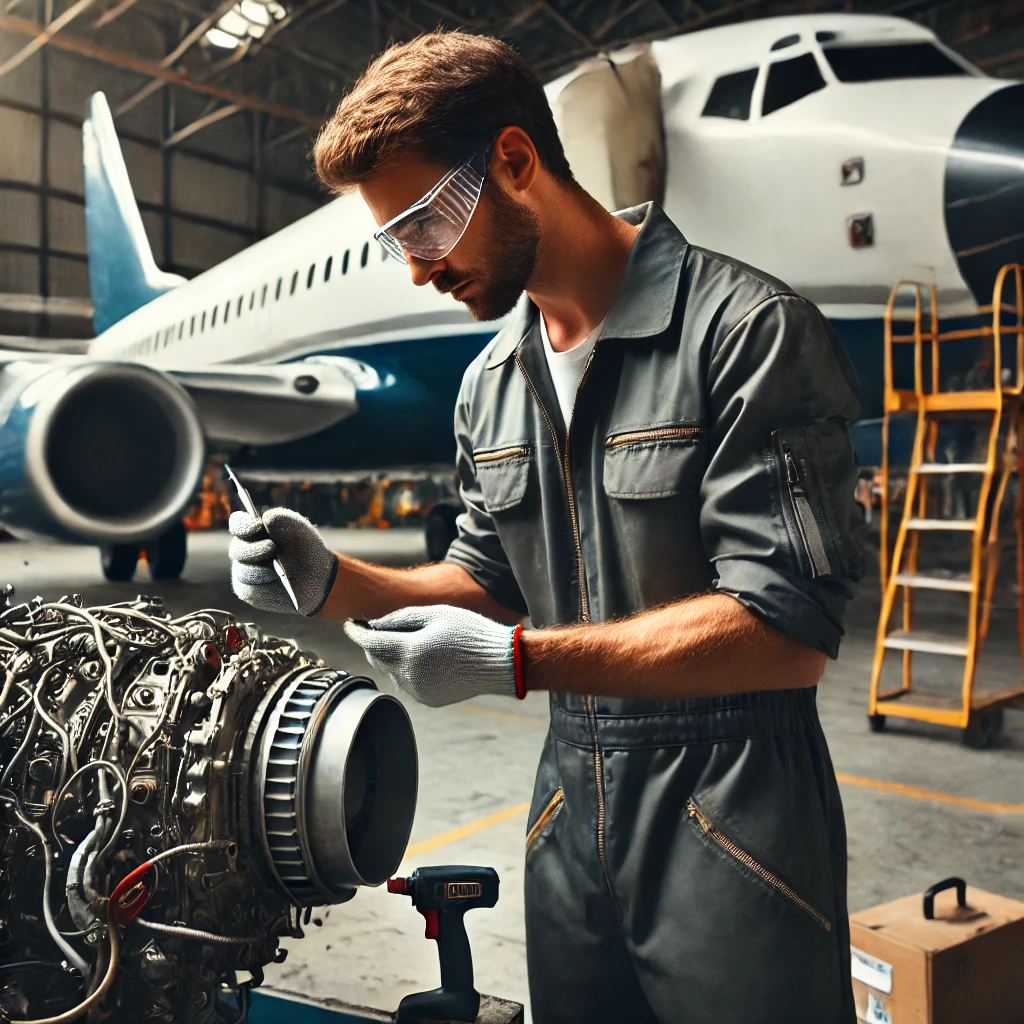When most people think about aviation, they picture pilots flying planes. But behind every successful flight is a skilled aircraft mechanic ensuring everything runs safely and smoothly. These professionals handle inspections, repairs, testing, and maintenance to keep planes airworthy and safe. With the growing demand for air travel, the need for aircraft mechanics is on the rise—offering stable, high-paying career opportunities, with earnings that can exceed six figures.
If you love aviation and enjoy working with your hands to solve problems, this could be the perfect career for you. This rewarding career offers long-term growth, plenty of advancement opportunities, and the satisfaction of playing a critical role in aviation safety. In this guide, we’ll walk you through what it takes to become an aircraft mechanic, the steps to get started, and how to build a successful career in this exciting field.
What Does an Aircraft Mechanic Do?
An aircraft mechanic is responsible for maintaining, repairing, and inspecting airplanes and helicopters to ensure they are safe and ready to fly. They also keep detailed records required by the FAA, manage tools and parts in the hangar, and make sure all mechanical components meet safety and operational standards. Aircraft mechanics are sometimes called aircraft maintenance technicians or aviation maintenance technicians.
Here are some of their typical responsibilities:
- Inspecting Aircraft Systems:
Aircraft mechanics carefully check both the inside and outside of airplanes during routine inspections. They look for potential issues to ensure the aircraft is safe to fly. - Diagnosing Problems:
Mechanics run tests to find the cause of issues with engines, electrical systems, and safety tools. - Measuring Aircraft Parts:
Using tools like gauges, mechanics measure parts to check for wear, corrosion, or damage over time. - Using Manuals and Blueprints:
Mechanics read manuals and blueprints to learn about specific aircraft and equipment. This helps them locate parts, fix problems, and order the correct replacements. - Repairing or Replacing Parts:
When something is broken, mechanics either fix it or replace it. This may involve using heavy tools to repair the aircraft body or its internal systems. - Cleaning Aircraft Components:
Regular cleaning of mechanical parts helps prevent rust, corrosion, and buildup that could affect the plane’s performance. - Updating Maintenance Records:
Mechanics document every inspection, repair, and update. These records are important for following industry rules and ensuring passenger safety.
Skills Needed for Aircraft Mechanics
Aircraft mechanics need both technical knowledge and soft skills to do their jobs well. Building skills in certain areas can help you succeed in this field. Here are some important skills for aircraft mechanics:
-
Attention to Detail:
Aircraft mechanics must notice small issues during inspections, as even minor problems can cause major safety risks. Being detail-oriented helps them catch anything broken or out of place.
-
Dexterity:
Working with both large and small airplane parts requires steady hands and good hand-eye coordination. Aircraft mechanics use physical dexterity to handle tools, adjust parts, and complete precise tasks.
-
Endurance:
Aircraft maintenance is physically demanding. Mechanics often work in tight, noisy spaces and may spend hours on a single repair. Strength and stamina are important for handling heavy tools and staying focused during long tasks.
-
Reading Comprehension:
Aircraft mechanics read and interpret technical manuals, blueprints, and repair instructions. Strong reading skills help them understand and follow complex information accurately.
-
Communication Skills:
Mechanics work closely with pilots, engineers, and other team members. They need clear verbal and written communication skills to document repairs, plan fixes with teammates, and discuss urgent problems with operators.
-
Troubleshooting:
Troubleshooting involves using logic and problem-solving to find the source of a mechanical issue. Aircraft mechanics rely on critical thinking to eliminate possible causes and identify the right solution.
Certifications
While it is not mandatory to have a license to work as an aircraft mechanic, obtaining one is highly recommended and often preferred by employers when evaluating a candidate’s qualifications. Most certification programs take about 12 to 24 months to complete. Earning a certification proves to employers that you have the necessary training and experience to perform the job safely and effectively. It also shows that you are prepared to work independently, which can make you a more competitive and attractive job candidate.
Average Aircraft Mechanic Salary
Aircraft mechanics in the United States earn an average salary of $69,631 per year. However, salaries can vary based on your location, employer, and certifications. Fewer than 10% of aircraft mechanics earn less than $40,000 annually, while the top 10% make over $77,000 per year. You can boost your earning potential by obtaining advanced certifications, completing specialized training, and gaining experience in the field.
Aircraft Mechanic Work Environment
Aircraft mechanics can work for various organizations that involve planes and helicopters, such as airports, government agencies, the military, and engineering companies. They operate in diverse environments, including hangars, workshops, and airfields, which may sometimes expose them to outdoor conditions.
The job often requires a significant amount of fieldwork, where mechanics visit airfields or hangars to perform repairs and maintenance. Some work directly on airfields, while others work inside hangars. Most aircraft mechanics follow an 8-hour rotating schedule, with weekend shifts being common.
Due to the physically demanding nature of the job, workplace injuries and illnesses are more likely compared to less labor-intensive roles.
Types of Opportunities
The aircraft maintenance field offers a wide range of career paths, including:
- Avionics Technician
- Airframe and Powerplant Mechanic
- Sheet Metal Mechanic
- Inspector
- Aircraft Engineer
- Painter
Professionals with these skills can find opportunities in various sectors, such as:
- Airlines
- Maintenance, Repair, and Overhaul (MRO) facilities
- Aircraft manufacturing companies
- Corporate flight departments
- General aviation
- The military
READ ALSO
How To Become a Solar Panel Installer
Top 8 Highest Paying Trade Jobs in Demand
How to Become an Aircraft Mechanic
Becoming an aircraft mechanic requires specific skills and training due to the technical nature of the job. There are several paths you can take, including formal education or hands-on work experience. Here’s a simple guide to the main steps:
1. Earn a High School Degree
Start by completing high school, as this is a basic requirement. Focus on math, science, engineering, or shop classes if available, as they can provide a strong foundation. Courses related to mechanics and construction can also be helpful for your future training.
2. Choose a Specialty
Decide what type of aircraft mechanic you want to become. The FAA offers two main specialties:
- Airframe Mechanics: Focus on the aircraft’s structure and systems.
- Powerplant Mechanics: Specialize in engines and fuel systems.
You can choose to be certified in one area or both. Mechanics with dual certification are known as A&P Mechanics (Airframe and Powerplant Mechanics), which increases job opportunities and earning potential.
3. Attend a Technical School
One way to qualify for an aircraft mechanic role is by attending an FAA-approved technical school. These programs teach you about aircraft systems, engines, and components, helping you gain the technical knowledge required for the job.
4. Complete On-the-Job Training
Another option is to gain qualifications through on-the-job (OTJ) training. This involves working in a professional environment for at least 18 months, focusing on either airframe or powerplant mechanics. You’ll start with simple tasks and gradually take on more complex work, gaining real-world experience as you go.
5. Study FAA Handbooks and Regulations
Understanding FAA rules and regulations is critical for passing certification exams and working safely. Spend time studying FAA handbooks, aviation codes, and safety standards to ensure you’re fully prepared.
6. Pass Certification Exams
After completing your training, you’ll need to pass the FAA certification exams. These include written tests, oral interviews, and practical assessments. You’ll demonstrate your technical skills and knowledge in front of an experienced examiner.
7. Apply for Jobs
Once certified, start applying for aircraft mechanic positions. Use job boards to find opportunities or join professional organizations like the Professional Aviation Maintenance Association (PAMA) or the Aircraft Mechanics Fraternal Association (AMFA) to network and learn about job openings. Tailor your resume to highlight your training, certifications, and hands-on experience.
Takeaway
Becoming an aircraft mechanic is both a challenging and rewarding career path, offering excellent pay, benefits, and opportunities for growth in the thriving aviation industry. Whether you choose to attend an Aircraft Maintenance Technical School or gain hands-on experience through on-the-job training, there are clear steps to help you get started. Remember, being an aircraft mechanic isn’t just about repairing planes—it’s about ensuring safety in the skies.

